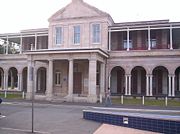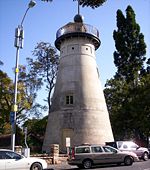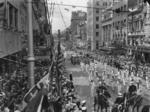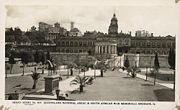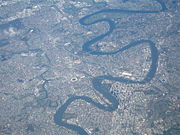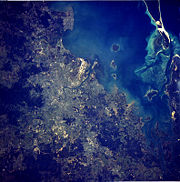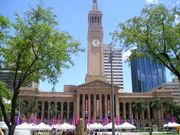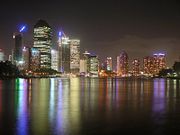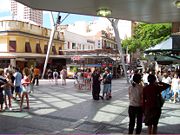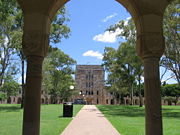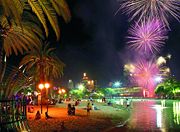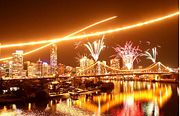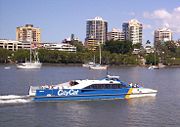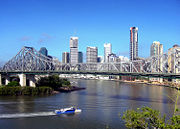Brisbane
2008/9 Schools Wikipedia Selection. Related subjects: Cities; Oceania (Australasia)
| Brisbane Queensland |
|||||||
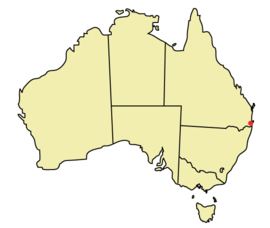 Brisbane's location in Australia |
|||||||
| Population: | 1,857,594 (2007) ( 3rd) | ||||||
| • Density: | 918/km² (2377.6/sq mi) (2006) | ||||||
| Established: | 1824 | ||||||
| Area: | 5904.8 km² (2279.9 sq mi) | ||||||
| Time zone: | AEST (No Daylight Saving) ( UTC+10) | ||||||
| Location: | |||||||
| LGA: | Brisbane, Ipswich, Logan, Moreton Bay, Redland | ||||||
| County: | Stanley | ||||||
| State District: | various (38) | ||||||
| Federal Division: | Blair, Bonner, Bowman, Brisbane, Dickson, Fadden, Forde, Griffith, Lilley, Longman, Moreton, Oxley, Petrie, Ryan | ||||||
|
|||||||
Brisbane (pronounced /ˈbɹɪzbən/) is the state capital of Queensland. Brisbane is the third largest city in Australia and the most populous city of Queensland. It is situated on the Brisbane River on a low-lying Floodplain between Moreton Bay and the Great Dividing Range in south-eastern Queensland. The local indigenous people knew the area as Mian-jin, meaning 'place shaped as a spike'. The city is named after Sir Thomas Brisbane, the Governor of New South Wales from 1821 to 1825.
The settlement at Brisbane developed after an abandoned initial penal colony settlement at Redcliffe, 28 kilometres (17 mi) north. The colony moved to the current location of the Brisbane central business district in 1825, and free settlers were permitted from 1842. It was chosen as the capital when Queensland was proclaimed a separate colony in 1859.
A large portion of Brisbane is controlled by the Brisbane City Council and also covers parts of several adjoining local government areas. In 1925, the City of Brisbane Act was passed by the Queensland Government, abolishing 20 local government authorities in the city and forming the largest local authority in Australia, covering 1,200 square kilometres (460 sq mi). The city played a central role in the Allied campaign during World War II as the South West Pacific headquarters for General Douglas MacArthur. More recently, Brisbane hosted the 1982 Commonwealth Games, 1988 World's Fair (Expo '88), and 2001 Goodwill Games.
History
Brisbane was inhabited before European settlement by the Turrbal people whose ancestors migrated to the region from across the Torres Strait. They knew the area as Mian-jin, meaning 'place shaped as a spike'.
The Moreton Bay area was initially explored by Matthew Flinders, landing and naming "Red Cliff Point" – after the red-coloured cliffs visible from the bay, known today as Woody Point – on 17 July 1799. In 1823, Governor of New South Wales, Thomas Brisbane, instructed that a new northern penal settlement be developed, and an exploration party led by John Oxley further explored Moreton Bay and sailed up the Brisbane River as far as Goodna, some 20 kilometres (12 mi) upstream from the Brisbane central business district. Oxley recommended Red Cliff Point for the new colony, reporting that ships could land at any tide and easily get close to the shore. The party settled in Redcliffe on 13 September 1824, under the command of Lieutenant Henry Miller with 14 soldiers, some with wives and children, and 29 convicts. However, this settlement was abandoned after one year and the colony was moved south to a site on the Brisbane River at North Quay, 28 kilometres (17 mi) south, that offered a more reliable water supply. Non-convict European settlement of the Brisbane region commenced in 1838.
German missionaries settled at Zions Hill, Nundah, as early as 1837, five years before Brisbane was officially declared a free settlement. The band consisted of two ministers, Christopher Eipper (1813-1894) and Carl Wilhelm Schmidt, and lay missionaries whose names were Haussmann, Johann Gottried Wagner, Niquet, Hartenstein, Zillman, Franz, Rode, Doege and Schneider. They were allocated 260 hectares and set about establishing the mission, which became known as German Station. Free settlers entered the area over the following five years and by the end of 1840 Robert Dixon began work on the first plan of Brisbane Town in anticipation of future development.
Queensland was proclaimed a separate colony on 6 June 1859 with Brisbane chosen as its capital, although it was not incorporated as a city until 1902. Over twenty small municipalities and shires were amalgamated in 1925, to form the City of Brisbane which is governed by the Brisbane City Council.
The Windmill in Wickham Park and the Old Commissariat Store on William Street are considered to be the oldest surviving buildings in Brisbane. Both were built by convict labour in 1828. The Windmill was originally used for the grinding of grain and a punishment for the convicts that manually operated the grinding mill. The Windmill tower’s other significant claim to fame, largely ignored, is that the first television signals in the southern hemisphere were transmitted from it by experimenters in April 1934—long before TV commenced in most places. These experimental TV broadcasts continued until World War II.
The Old Commissariat Store, originally used partly as a grainhouse, has also been a hostel for immigrants and used for the storage of records. Built with Brisbane tuff from the nearby Kangaroo Point Cliffs and sandstone from a quarry near today's Albion Park Racecourse, it is now the home of the Royal Historical Society of Brisbane. It contains a museum and can also be hired for small functions.
The Shrine of Remembrance, in ANZAC Square, is Brisbane's main war memorial. The Shrine was dedicated at 11:00 am on 11 November 1930.
During World War II, Brisbane became central to the Allied campaign when the AMP Building (now called MacArthur Central) was used as the South West Pacific headquarters for General Douglas MacArthur, chief of the Allied Pacific forces. MacArthur had previously rejected using the University of Queensland complex as his HQ, as the distinctive bends in the river at St Lucia could have aided enemy bombers. Also used as a Headquarters by the American troops during World War II was the T & G Building. Approximately 1,000,000 US troops passed through Australia during the war, as the primary coordination point for the South West Pacific. In 1942 Brisbane was the site of a violent clash between visiting US military personnel and Australian servicemen and civilians which resulted in one death and several injuries. This incident became known colloquially as the Battle of Brisbane.
Brisbane staged the successful Commonwealth Games during 1982, and World's Fair (known locally as Expo '88) during 1988. These events were accompanied by a scale of public expenditure, construction and development not previously seen in the state of Queensland.
Geography
Brisbane is in the southeast corner of Queensland, Australia. The city is centred around the Brisbane River, and its eastern suburbs line the shores of Moreton Bay. The greater Brisbane region is on the coastal plain east of the Great Dividing Range
The urban area is partially elevated by two large hills reaching up to 300 metres (980 ft), Mount Coot-tha and Mount Gravatt in the south. Mount Petrie at 170 metres (560 ft) and the smaller rises of Enoggera Hill, Highgate Hill, Mount Ommaney, Stephens Mountain, Toohey Mountain and Whites Hill are dotted across the city.
The city is on a low-lying floodplain. Many suburban creeks criss-cross the city, increasing the risk of flooding. The city has suffered two major floods since colonisation, in 1893 and 1974. The 1974 Brisbane flood occurred partly as a result of " Cyclone Wanda". Non-stop heavy rain had fallen for three weeks prior to the Australia Day weekend flood (26 – 27 January, 1974). The flood damaged many parts of the city, especially the suburbs of Oxley, Bulimba, Rocklea, Coorparoo, Toowong and New Farm. The City Botanic gardens were inundated, leading to a new colony of mangroves forming in the City Reach of the Brisbane River.
The Brisbane central business district lies in a curve of the Brisbane river. It covers only 2.2 km² (0.8 sq mi) and is navigable on foot. Central streets are named after members of the royal family. Streets named after female members ( Adelaide, Alice, Ann, Charlotte, Elizabeth, Margaret, Mary) run parallel to Queen Street and Queen Street Mall (named in honour of Queen Victoria) and perpendicular to streets named after male members ( Albert, Edward, George, William).
Brisbane has a lower inner city population density than Australia's two largest cities, Sydney and Melbourne, although constant population growth is closing that gap. The lower population density reflects the fact that most of Brisbane's housing stock consists of detached houses. Early legislation decreed a minimum size for residential blocks resulting in few terrace houses being constructed in Brisbane. The high density housing that existed came in the form of miniature Queenslander-style houses which resemble the much larger traditional styles but are sometimes only one quarter the size. These miniature Queenslanders are becoming scarce but can still be seen in the inner city suburbs. Multi residence accommodations (such as apartment blocks) are relatively new to Brisbane, with few such blocks built before 1970, other than in inner suburbs such as New Farm. Pre-1950 housing was often built in a distinctive architectural style known as a Queenslander, featuring timber construction with large verandahs and high ceilings. The relatively low cost of timber in South-East Queensland meant that until recently most residences were constructed of timber, rather than brick or stone. Many of these houses are elevated on stumps (also called "stilts"), that were originally timber, but are now frequently replaced by steel or concrete.
The city has a density of 379.4 people per square kilometre, which is comparable to that of Sydney. Recently the density of the city and inner city neighbourhoods has increased with the construction of apartments, with the result that the population of the central business district has doubled over the last 5 years.
Climate
Brisbane has a humid subtropical climate ( Koppen climate classification Cfa) with hot, humid summers and dry, mild winters. From late Spring through to early Autumn, thunderstorms are common over the greater Brisbane area, with the more severe events accompanied by large damaging hail stones, torrential rain and destructive winds.
The city's highest recorded temperature was 43.2 °C (110 °F) on 26 January 1940. On 19 July 2007, Brisbane's temperature fell below freezing point for the first time since records began, registering −0.1 °C (31.8 °F) at the airport. Brisbane's wettest day was 21 January 1887, when 465 millimetres (18.3 in) of rain fell on the city, the highest maximum daily rainfall of Australia's capital cities. From 2006, Brisbane and surrounding temperate areas have experienced the most severe drought in over a century, with dam levels dropping below one quarter of their normal capacity. Residents have been mandated by local laws to observe level 6 water restrictions on gardening and other outdoor water usage. Per Capita water usage is below 140 litres per day, giving Brisbane one of the lowest per capita usages of water of any Western city in the world.
| Month | Jan | Feb | Mar | Apr | May | Jun | Jul | Aug | Sep | Oct | Nov | Dec | Year |
|---|---|---|---|---|---|---|---|---|---|---|---|---|---|
| Temperatures (°C) | |||||||||||||
| Mean daily maximum | 29.0 | 29.1 | 28.1 | 26.1 | 23.7 | 21.2 | 20.9 | 21.7 | 24.2 | 25.5 | 26.6 | 28.2 | 25.4 |
| Highest recorded maximum | 37.4 (20th 2000) |
40.2 (22nd 2004) |
34.2 (30th 2007) |
32.2 (4th 2006) |
30.6 (20th 2003) |
27.9 (16th 2002) |
27.6 (13th 1995) |
27.7 (10th 2007) |
33.4 (27th 2003) |
36.7 (30th 2001) |
37.9 (7th 1994) |
36.5 (25th 2001) |
|
| Mean daily minimum | 21.1 | 21.1 | 19.4 | 16.3 | 12.9 | 10.4 | 8.8 | 9.6 | 12.6 | 15.8 | 17.9 | 20.0 | 15.5 |
| Lowest recorded minimum | 16.0 (12th 2005) |
14.6 (14th 1996) |
13.1 (27th 2005) |
8.3 (28th 1999) |
3.0 (31st 2006) |
2.5 (21st 2004) |
-0.1 (19th 2007) |
1.9 (8th 1995) |
3.7 (7th 1995) |
8.3 (9th 1994) |
8.3 (17th 2006) |
14.4 (29th 2006) |
|
| Precipitation (millimetres) | |||||||||||||
| Mean total rainfall | 122.2 | 111.2 | 80.6 | 56.6 | 115.4 | 67.0 | 24.5 | 42.5 | 33.9 | 69.8 | 102.6 | 125.3 | 946.1 |
| Highest recorded total | 284.8 (2004) |
284.0 (1999) |
177.6 (1999) |
192.2 (1998) |
577.2 (1996) |
213.2 (1999) |
112.4 (1999) |
138.0 (1998) |
122.0 (1998) |
175.2 (1999) |
212.6 (2001) |
253.4 (2004) |
1728.8 (1999) |
| Lowest recorded total | 9.4 (2003) |
30.6 (1996) |
19.8 (2005) |
12.6 (2007) |
9.4 (2006) |
0.0 (1996) |
0.8 (1995) |
0.0 (1996) |
0.8 (2000) |
9.0 (2006) |
38.4 (2002) |
53.4 (2000) |
490.4 (2000) |
| Notes: Temperatures are in degrees Celsius. Precipitation is in millimetres. Brisbane Airport Latitude: 27.39S Longitude: 153.13E Elevation: 4 m ASL | |||||||||||||
Governance
Unlike other Australian capital cities, a large portion of the greater metropolitan area of Brisbane is controlled by a single local government entity, the Brisbane City Council. Since the creation of the Brisbane City Council in 1925 the urban areas of Brisbane have expanded considerably past the City Council boundaries.
The City of Brisbane is divided into 26 wards, with each ward electing a Councillor as their community representative. The Lord Mayor of Brisbane and Councillors are elected every four years by popular vote, in which all residents must participate. The current Lord Mayor of Brisbane is Campbell Newman, who was elected to the position in March 2004 and re-elected in 2008.
Brisbane City Council is the largest local government body (in terms of population and budget) in Australia. The Council, formed by the merger of twenty smaller councils in 1925, has jurisdiction over an area of 1367 km². The Council's annual budget is approximately $1.6 billion, and it has an asset base of $13 billion.
The Brisbane metropolitan area now covers parts of several adjoining local government areas including Moreton Bay, Ipswich City, Logan City and Redland Shire.
Economy
Brisbane's economy has white-collar and blue-collar industries. White-collar industries include information technology, financial services, higher education and public sector administration generally concentrated in and around the central business district and recently established office areas in the inner suburbs. Blue-collar industries, including petroleum refining, stevedoring, paper milling, metalworking and QR railway workshops, tend to be located on the lower reaches of the Brisbane River and in new industrial zones on the urban fringe. Tourism is an important part of the Brisbane economy, both in its own right and as a gateway to other areas of Queensland.
Since the late 1990s and early 2000s, the Queensland State Government has been developing technology and science industries in Queensland as a whole, and Brisbane in particular, as part of its "Smart State" initiative. The government has invested in several biotechnology and research facilities at several universities in Brisbane. The Institute for Molecular Bioscience at the University of Queensland (UQ) Saint Lucia Campus is a large CSIRO and Queensland state government initiative for research and innovation that is currently being emulated at the Queensland University of Technology (QUT) Campus at Kelvin Grove with the establishment of the Institute of Health and Biomedical Innovation (IHBI).
The Port of Brisbane is on the lower reaches of the Brisbane River and on Fisherman's Island at the rivers mouth, and is the 3rd most important port in Australia for value of goods. Container freight, sugar, grain, coal and bulk liquids are the major exports. Most of the port facilities are less than three decades old and some are built on reclaimed mangroves and wetlands. The Port is a part of the Australia TradeCoast, the country's fastest-growing economic development area. Geographically, Australia TradeCoast occupies a large swathe of land around the airport and port. Commercially, the area has attracted a mix of companies from throughout the Asia Pacific region.
Brisbane is one of the major business hubs in Australia. Most major Australian companies, as well as numerous international companies, have contact offices in Brisbane, while numerous electronics business haves distribution hubs in and around the city. DHL Global's Oceanic distribution warehouse is located in Brisbane, as is Asia Pacific Aerospace's headquarters.
Home grown major companies include Suncorp-Metway Limited, Flight Centre, Sunsuper, Orrcon, Credit Union Australia, Donut King, Wotif.com, WebCentral, PIPE Networks, Krome Studios, Mincom Limited and Virgin Blue.
Brisbane has a range of retail precincts, both in the central business district and in the suburbs. The Queen Street Mall has restaurants, cinemas, souvenir outlets and shopping centres, including: Wintergarden, Broadway on the Mall, QueensPlaza, Brisbane Arcade and The Myer Centre.
The majority of retail business is done within the suburbs of Brisbane in shopping centres which include major department store chains. There are 3 major Westfield shopping centres in Brisbane located in the suburbs of Chermside ( Westfield Chermside), Mt Gravatt ( Westfield Garden City) and Carindale ( Westfield Carindale). Other large shopping centres exist at Indooroopilly ( Indooroopilly Shopping Centre), Toombul ( Centro Toombul) and Mitchelton ( Brookside Shopping Centre).
Demographics
At the 2006 census the population of Brisbane was 1,763,131, making it the third largest city in Australia. Brisbane recorded the largest growth rate of all capital cities in the last Census, with an annual growth rate of 2.2%
The Australian Census in 2006 showed that 1.7% of Brisbane's population were of indigenous origin and 21.7% were born overseas, Of those born outside of Australia, the three main countries of birth were New Zealand, South Africa, and the United Kingdom. Approximately 16.1% of households spoke a language other than English, with the most common being Mandarin, Vietnamese and Cantonese. The median population age across the city was 35 years.
Education
Brisbane has multi-campus universities and colleges including the University of Queensland (a member of the Group of Eight and Universitas 21), Queensland University of Technology and Griffith University. Other universities which have campuses in Brisbane include the Australian Catholic University, Central Queensland University, James Cook University, the University of the Sunshine Coast and the University of Southern Queensland.
There are three major TAFE colleges in Brisbane; the Brisbane North Institute of TAFE, the Metropolitan South Institute of TAFE, and the Southbank Institute of TAFE. Brisbane is also home to numerous other independent tertiary education providers, including the Australian College of Natural Medicine, the Brisbane College of Theology, QANTM, as well as Jschool: Journalism Education & Training.
The majority of Brisbane's preschool, primary, and secondary schools are run under the jurisdiction of Education Queensland, a branch of the Queensland Government. There are also a large number of independent and Roman Catholic run schools.
Culture
Arts and entertainment
Brisbane has a growing live music scene, both popular and classical. The Queensland Performing Arts Complex consists of the Lyric Theatre, a Concert Hall, Cremorne Theatre and the Playhouse Theatre. The Queensland Ballet, Opera Queensland, Queensland Theatre Company and other performance art groups stage regular performances in the different venues. The La Boite Theatre Company performs at the Roundhouse Theatre at Kelvin Grove. The Powerhouse complex, Twelfth Night Theatre and Brisbane Arts Theatre also stage productions throughout the year.
Along with Beijing, Berlin, Birmingham and Marseille, Brisbane was nominated as one of the Top 5 International Music Hotspots by Billboard in 2007. There are also popular entertainment pubs and clubs within both the City and Fortitude Valley.
The Queensland Museum is located at South Bank. The Queensland Gallery of Modern Art (GOMA), opened in December 2006, is one of the latest additions to the South Bank area and houses some of the most well-known pieces of modern art from within and outside Australia. GOMA is the largest modern art gallery in Australia. GOMA holds the Asia Pacific Triennial (ATP) which focuses on contemporary art from the Asia and Pacific in a variety of media from painting to video work. In Addition, its size enables the gallery to exhibit particularly large shows — the Andy Warhol exhibition being the largest survey of his work in Australia. GOMA also boasts Australia's largest purpose-built Cinémathèque. The Gallery of Modern Art is located next to the State Library of Queensland and the Queensland Art Gallery.
The Brisbane Powerhouse in New Farm and the Judith Wright Centre of Contemporary Arts on Brunswick Street in Fortitude Valley also feature diverse programs featuring exhibitions and festivals of visual art, music and dance.
Annual events
Major cultural events in Brisbane include the Ekka (the Royal Queensland Show), held each August, and the Riverfestival, held each September at South Bank Parklands and surrounding areas. Warana, (meaning Blue Skies), was a former spring festival which began in 1961 and was held in September each year. Run as a celebration of Brisbane, Warana was similar to Melbourne's Moomba festival. In 1996 the annual festival was changed to a biennial Brisbane Festival.
The Brisbane International Film Festival (BIFF) is held in July/August in a variety of venues around Brisbane including the Regent Cinema in Queen Street Mall. BIFF features new films and retrospectives by domestic and international filmmakers along with seminars and awards.
The Paniyiri festival at Musgrave Park (corner of Russell and Edmondstone Streets, South Brisbane) is an annual Greek cultural festival held on the first weekend in May. The Brisbane Medieval Fayre and Tournament is held each June in Musgrave Park.
The Valley Fiesta is an annual three-day event organised by the Valley Chamber of Commerce. It was launched by Brisbane Marketing in 2002 to promote Fortitude Valley as a hub for arts and youth culture. It features free live music, market stalls, food and drink from many local restaurants and cafés, and other entertainment.
The Bridge to Brisbane fun run has become a major annual charity event for Brisbane.
Tourism and recreation
Popular recreation areas in Brisbane include the South Bank Parklands, Roma Street Parkland, and City Botanic Gardens. The suburb of Mount Coot-tha is home to a popular state forest, and the Brisbane Botanic Gardens which houses the Sir Thomas Brisbane Planetarium and the "Tsuki-yama-chisen" Japanese Garden. Brisbane has over 27 km (16.8 mi) of bicycle pathways, mostly surrounding the Brisbane river and city centre, extending to the west of the city. Lone Pine Koala Sanctuary and Brisbane Forest Park, located in the city, are popular tourist destinations alongside the Story Bridge adventure climb and Portside Wharf.
Sport
Brisbane has hosted several major sporting events including the 1982 Commonwealth Games and the 2001 Goodwill Games. The city also hosted events during the 1987 Rugby World Cup, 1992 Cricket World Cup, 2000 Sydney Olympics, the 2003 Rugby World Cup and will host the Grand Final of the 2008 Rugby League World Cup. In 2005, then Premier Peter Beattie announced plans for Brisbane to bid to host the 2024 Olympic Games.
Two of the city's major sporting venues are the Sleeman Centre at Chandler, and the stadium facilities of the Queensland Sport and Athletics Centre in Nathan. With the closure of the Milton Tennis grounds in 1994, Brisbane lacks a major tennis facility. In 2005, the State Government approved the State Tennis Centre a new A$65 million tennis stadium. Construction of the Tennis Centre was started in May 2006, with a completion date scheduled for December 2008. Brisbane has teams in all major interstate competitions, including:
| Sport | Team Name | League | Stadium | Reference |
|---|---|---|---|---|
| Rugby League | Queensland | State of Origin | Suncorp Stadium | |
| Brisbane Broncos | National Rugby League | |||
| Rugby Union | Queensland Reds | Super 14 | Suncorp Stadium | |
| Football (soccer) | Queensland Roar FC | A-League | Suncorp Stadium | |
| Cricket | Queensland Bulls | Pura Cup Ford Ranger One Day Cup KFC Twenty20 Big Bash |
The Gabba | |
| Australian rules football | Brisbane Lions | Australian Football League | The Gabba | |
| Basketball | Brisbane Bullets | National Basketball League | Brisbane Convention & Exhibition Centre | |
| Netball | Queensland Firebirds | ANZ Championship | Chandler Arena | |
| Motorsport | Triple Eight Race Engineering | V8Supercar Championship Series | Queensland Raceway |
Infrastructure
Health
Brisbane is covered by Queensland Health's "Northside" and "Southside" health service areas. Within the greater Brisbane area there are 8 major public hospitals, 4 major private hospitals, and smaller public and private facilities. Specialist and general medical practices are located in the CBD, and most suburbs and localities. Private hospitals in Brisbane include Greenslopes Private Hospital, Redlands Private Hospital, Mater Private Hospital, Brisbane Private and RBH Private.
Transport
Early transport developed along dirt roads that are now replaced with paved roads and via the Brisbane River with various ferry services. Trams serviced the city between 1885 and 1969, while railway networks spread across Brisbane into the expanding nearby regions during the 1870s. Today, as Queensland's largest city and state capital, Brisbane has an extensive transportation network within the city, as well as connections to regional centres, interstate and to overseas destinations.
The use of urban public transport is still only a small component of total passenger transport, the largest component being travel by private car .
Public Transport in Brisbane is provided by bus, rail and ferry services. Bus services are operated by public and private operators whereas trains and ferries are operated by public agencies. The Brisbane central business district (CBD) is the central hub for all public transport services with services focusing on Queen Street Bus Station, Roma Street and Central railway stations, and various city ferries wharves. Brisbane's CityCat high speed ferry service, popular with tourists and commuters, operates services along the Brisbane River between the University of Queensland and Brett's Wharf.
The Citytrain urban rail network consists of 10 suburban lines and covers mostly the west, north and east sides of the city. It also provides the route for an Airtrain service under joint public/private control between the City and Brisbane Airport. Since 2000, Brisbane has been developing a network of busways, including the South-East Busway and the Inner-Northern Busway, to provide faster bus services. " TransLink", an integrated ticketing system operates across the public transport network.
The Brisbane River has created a barrier to some road transport routes. In total there are six road bridges, mostly concentrated in the inner city area. This has intensified the need for transport routes to focus on the inner city. There are also three railway bridges and one pedestrian bridge. The Eleanor Schonell Bridge (originally named The Green Bridge) between the University of Queensland and Dutton Park is for use by buses, pedestrians and cyclists. There are currently multiple tunnel and bridge projects underway as part of the TransApex plan. For further information about Brisbane's bridges, see the article Bridges of Brisbane.
An extensive network of pedestrian and cyclist pathways have been created along the banks of the Brisbane River to form a Riverwalk network.
Brisbane is served by several freeways. The Pacific Motorway connects the central city with the Gold Coast to the south. The Ipswich Motorway connects the city with Ipswich to the west via the southern suburbs, while the Western Freeway and the Centenary Freeway provide a connection between Brisbane's inner-west and the outer south-west, connecting with the Ipswich Motorway south of the Brisbane River. The Bruce Highway is Brisbane's main route north of the city to the rest of the State. The Bruce Highway terminates 1700 km away in Cairns and passes through most major cities along the Queensland coast. The Gateway Motorway is a private toll road which connects the Gold Coast and Sunshine Coasts by providing an alternate route avoiding Brisbane's inner city area. The tollroad crosses the Brisbane River to the east of the city over the Gateway Bridge. The Gateway Motorway connects with Bruce Highway and the Pacific Motorway. A duplicate of the bridge is planned to be built in parallel to cope with the area's growing population. The Port of Brisbane Motorway links the Gateway to the Port of Brisbane, while Inner City Bypass and the Riverside Expressway act as the inner ring freeway system to prevent motorists from travelling through the city's congested centre.
Brisbane's population growth placed strains on South East Queensland's transport system. The State Government and Brisbane City Council have responded with infrastructure plans and increased funding for transportation projects, such as the South East Queensland Infrastructure Plan and Program. Most of the focus has been placed on expanding current road infrastructure, particularly tunnels and bypasses, as well as improving the public transport system.
Brisbane Airport (IATA code: BNE) is the city's main airport, the third busiest in Australia after Sydney Airport and Melbourne Airport respectively. It is located near Eagle Farm, north-east of the city centre and provides domestic and international passenger services. Archerfield Airport (in Brisbane's southern suburbs) acts as a general aviation airport.
Utilities
Water storage, treatment and delivery for Brisbane is handled by SEQ Water, which sells on to Brisbane Water for distribution to the greater Brisbane area. Water for the area is stored in one of three dams; Wivenhoe, Somerset and North Pine. As of 13 May 2005, Brisbane has enforced water restrictions due to drought. This has also led to the State Government announcing that recycled sewage will be pumped into the dams once the pipeline is complete in 2009.
Electricity and gas grids in Brisbane are handled by Energex (electricity), and Origin Energy (gas), with each company previously holding a monopoly on domestic retail supply. Since July 1, 2007 Queensland regulation changes have opened up the retail energy market, allowing multiple companies to resell both gas and electricity.
Metropolitan Brisbane is serviced by all major and most minor telecommunications companies and their networks. Brisbane has the largest number of enabled DSL telephone exchanges in Queensland. An increasing number are also enabled with special hardware ( DSLAMs) which enable high speed ADSL2+ internet access. The Brisbane CBD also features a complete underground fibre optics network, with numerous connections to the inner suburbs provided by various service providers.
Telstra and Optus provide both high speed internet as well as Pay TV through their cable services for the bulk of the city's metropolitan area. Both of these providers also host wireless networks with hotspots within both the inner and suburban areas. In addition, 3 Mobile, Telstra, Optus and Vodafone all operate both 2.5G, 3G and 3.5G mobile phone networks citywide.
